Simulating accurate observations of star clusters is really annoying! So as a part of this paper, we open sourced all of the code we used to simulate them, and there's a Python notebook that explains how to do it right here: 🔭☄️ #galactic #astrocode
22.10.2025 15:20 — 👍 31 🔁 4 💬 3 📌 0

A great paper led by Josefa Großschedl has a appeared on arxiv this morning!
A detailed study on the velocity dispersion of the subgroups of Sco-Cen, the nearest OB association. The expansion of the complex is driven by stellar feedback, engendering a sequential star formation process.
#astronomy
25.09.2025 09:08 — 👍 9 🔁 2 💬 1 📌 0
but those we can find are worth looking for ☝️🙂↕️
19.09.2025 07:30 — 👍 4 🔁 0 💬 0 📌 0

Figure 16: Sky projections, in Galactic coordinates, showing various properties of the Gaia DR3 data release (see text for details).
Gargantuan Gaia review by Michael Perryman
"271 pages, 126 figures, accepted for publication in Physics Reports"
arxiv.org/abs/2509.10883
16.09.2025 03:46 — 👍 53 🔁 16 💬 1 📌 3
Just about a month until we kick off "Stellar Origins" in Vienna! 👀 Until then, we'll keep you updated here with news on the scientific program and some sneak peeks of what else we have planned for you! Stay tuned and tell your friends! #stellarorigins2025
13.08.2025 10:30 — 👍 8 🔁 2 💬 0 📌 2
weaponized avoidance
11.08.2025 08:17 — 👍 0 🔁 0 💬 0 📌 0
prioritätenliste machen die man dann trotzdem net einhält >>>>
29.07.2025 13:32 — 👍 2 🔁 0 💬 0 📌 0

The Superclouds of the Local Milky Way
Recent 3D dust maps of the local Milky Way are revolutionizing our understanding of the Sun's Galactic neighborhood, bringing much-needed insight into the large-scale organization of the interstellar ...
An exciting paper has appeared today, led by Lily Kormann from the University of Vienna! With the extinction map from Edenhofer et al. (2024), they discovered seven local superclouds, only two of which, The Radcliffe Wave and The Split, were already known!
#galactic
arxiv.org/abs/2507.14883
22.07.2025 08:45 — 👍 11 🔁 2 💬 0 📌 0
🎉🎉🎉🎉
07.07.2025 14:51 — 👍 1 🔁 0 💬 0 📌 0
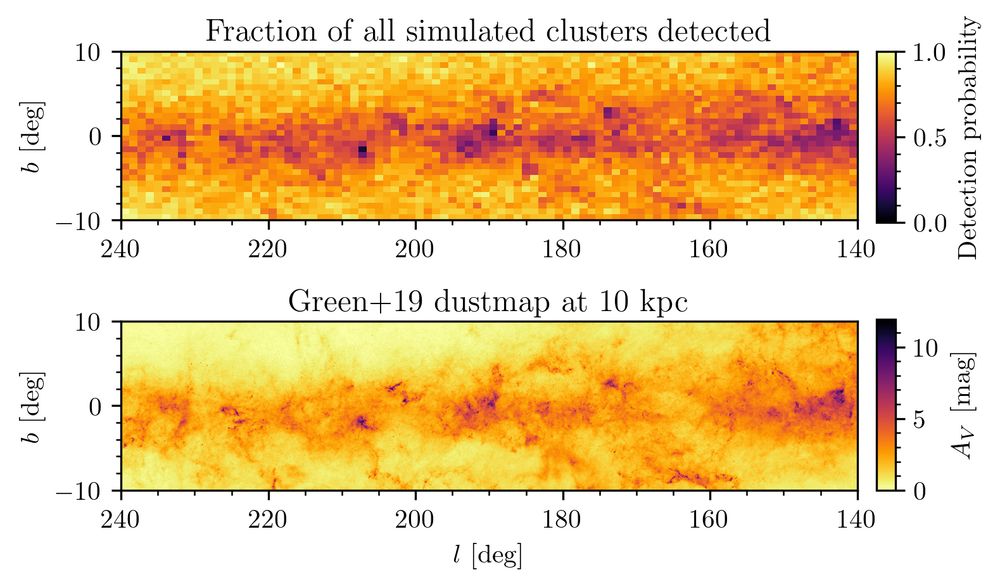
The fraction of simulated clusters we recover (upper panel) compared against a dust map (lower panel.) Dust is clearly a major hindrance to seeing open clusters with Gaia.

The detectability of young clusters (upper panel) and old clusters (lower panel) in the anticentre of our galaxy. Grey points show real clusters. It's clear that there's a huge void where we're not sensitive enough to say if there are more old clusters.
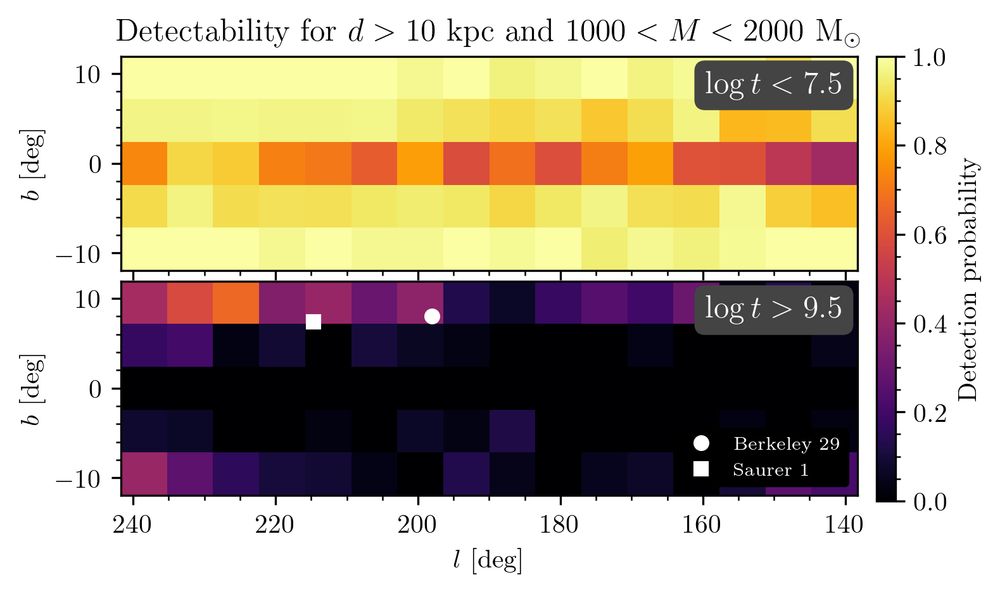
The detectability of old clusters, shown a different way. The two most distant catalogued clusters in the anticentre (Saurer 1 & Berkeley 29) appear to simply be lucky detections, as they sit in a small (not so reddened) part of the anticentre.
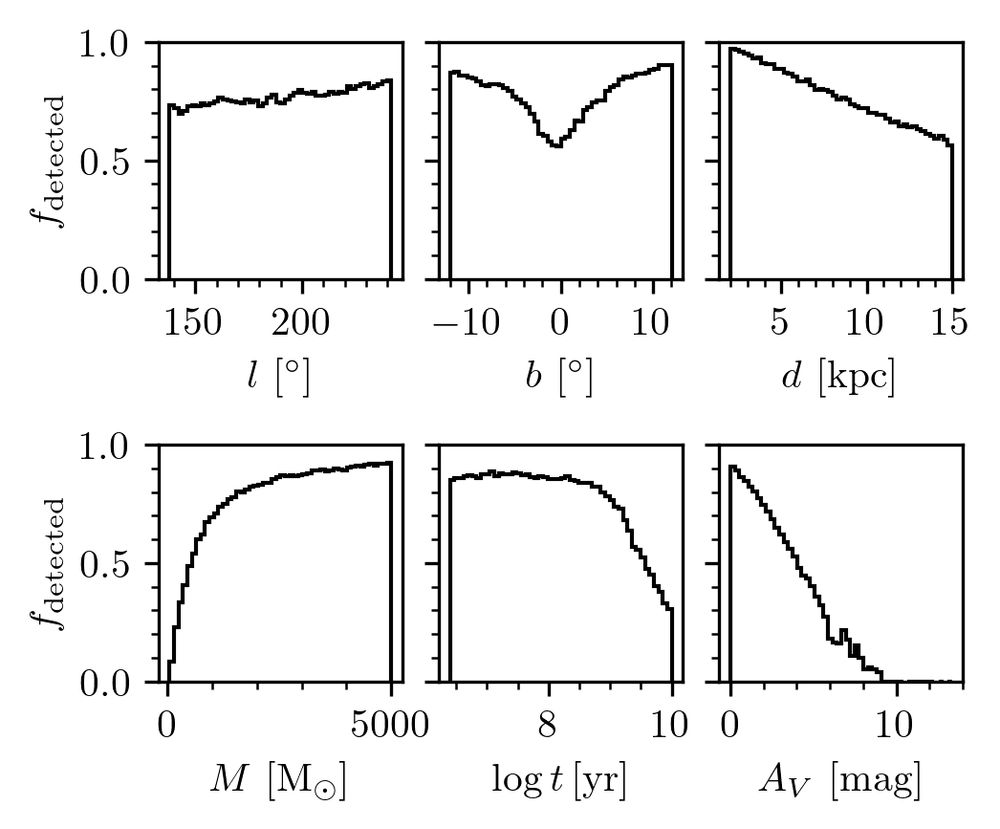
General trends in cluster detectability in the region as a function of various parameters. Mass, age, extinction, and distance are the biggest culprits.
How many open clusters could be hiding at the edge of our galaxy? 🔭☄️🧪 #galactic
Our new paper out today (A&A, accepted) pioneers a new way to test the completeness of cluster catalogues built with @esa.int's Gaia mission!
24.06.2025 12:28 — 👍 62 🔁 10 💬 1 📌 1
favorite part of the day when the badgers come out and make noise outside of my window and I get to watch them snack on raspberries
21.06.2025 19:43 — 👍 2 🔁 0 💬 0 📌 0
there are so many more stars in space today than there were before the invention of the telescope. where did they suddenly come from? I think big telescope are putting more stars in space to control us. wake up sheeple!
26.04.2025 09:47 — 👍 70 🔁 14 💬 7 📌 2
🫥👎
16.04.2025 09:02 — 👍 1 🔁 0 💬 0 📌 0
also would love to get diagnosed with a cluster 🤲
15.04.2025 09:35 — 👍 1 🔁 0 💬 1 📌 0

Backwards orbital integration of star clusters near the Sun in their work. Notice how all the grey dots originate in three areas. (Their Fig. 1)
An interesting #galactic paper by Cameren Swiggum (@mac0598.bsky.social) et al. came out today! ☄️🧪
Extending previous work that showed most young star clusters near to the Sun came from just three regions, Cameren shows that actually *all* nearby clusters come from just three regions!
04.04.2025 08:26 — 👍 58 🔁 15 💬 2 📌 1

Cool paper out by Juan D. Soler et al! They looked at the line-of-sight motion of the ISM based on 3D dust maps, HI and CO line emission, creating several maps of how the dust and gas in our solar neighborhood move! 🔭🧪
www.aanda.org/articles/aa/...
26.03.2025 20:01 — 👍 10 🔁 1 💬 1 📌 0
YouTube video by ESA Gaia Mission
Final goodbye to Gaia from China
I'm not sure I'm emotionally prepared to say goodbye to Gaia. This video, shared by @esa.int, is the spacecraft fading from view for the final time. It's still alive, but will be switched off on Thursday. 🔭 www.youtube.com/watch?v=-NGh...
24.03.2025 12:14 — 👍 73 🔁 16 💬 4 📌 4
not to be italian on main but if lewis turns that pole into a win i'll revert to catholicism
21.03.2025 10:39 — 👍 3 🔁 0 💬 0 📌 0
happy ides of march to those who celebrate
15.03.2025 11:27 — 👍 2 🔁 0 💬 0 📌 0

Astronomy’s dirty window to space
Astronomers from the Max Planck Institute for Astronomy have constructed the first detailed 3D map of the properties of cosmic dust in our home galaxy.
New result from MPIA: Two of our astronomers have taken a look at just how "dirty" our window into deep space is, concretely: they have mapped the properties of dust out there in the Milky Way, including how that dust absorbs light. www.mpia.de/news/science...
14.03.2025 18:55 — 👍 22 🔁 6 💬 0 📌 3

this part
03.03.2025 10:11 — 👍 2 🔁 0 💬 0 📌 0
never underestimate what a little spring hike in the mountains can do for your mental sanity!
01.03.2025 20:21 — 👍 2 🔁 0 💬 1 📌 0
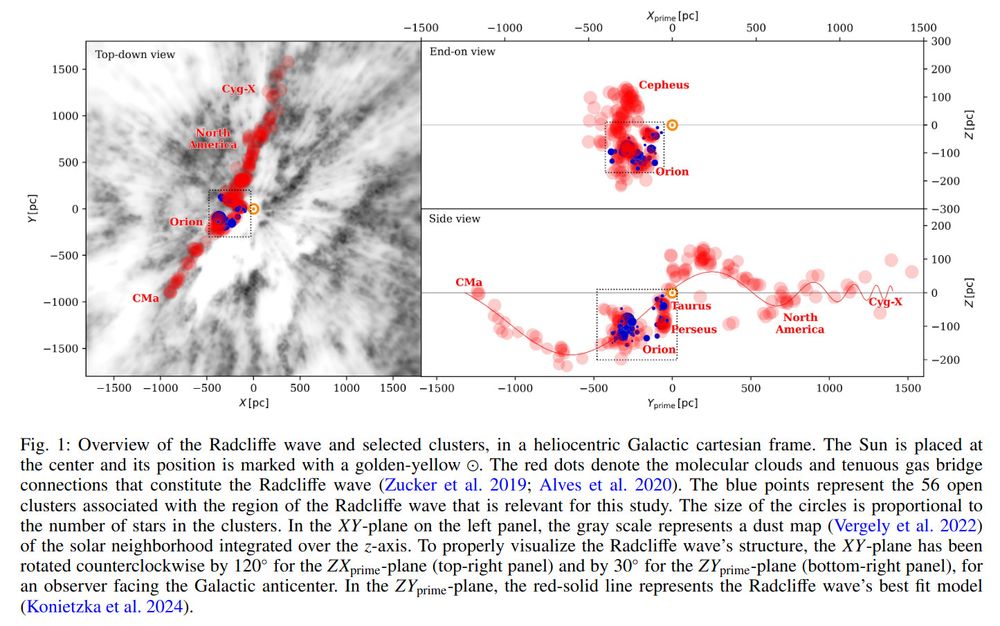
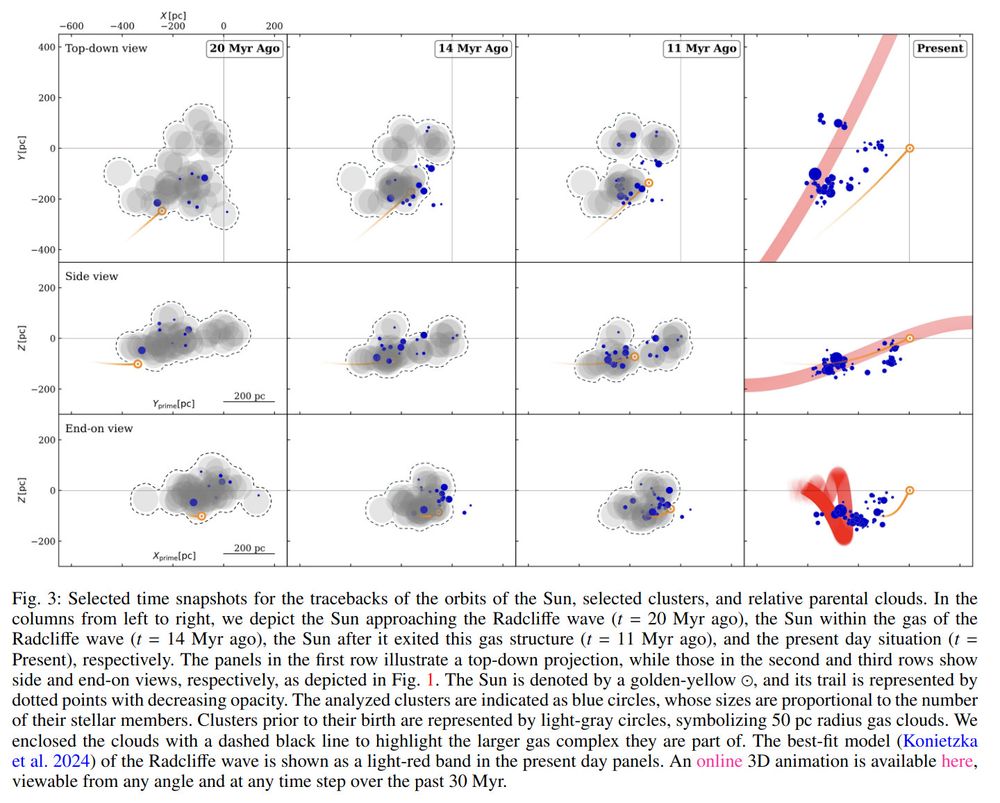
Interesting paper out today by Efrem Maconi, @joaoalves.bsky.social et al.! They find that the Sun probably passed through a massive wave of interstellar dust and gas (the Radcliffe wave) around 11 to 18 million years ago. 🔭🧪 #milkyway #planetsci arxiv.org/abs/2502.16360
25.02.2025 12:47 — 👍 82 🔁 18 💬 4 📌 2
as much as I like to complain about austrian trains they popped off with the nightjets
06.02.2025 08:18 — 👍 7 🔁 0 💬 0 📌 0
trans icon 🏳️⚧️🏳️⚧️
06.02.2025 07:51 — 👍 2 🔁 0 💬 0 📌 0
stop 👏 putting 👏clusters 👏 in 👏 boxes 👏
05.02.2025 08:58 — 👍 2 🔁 0 💬 1 📌 0
This is SUCH bullshit - so so frustrating that even factual phrases like "Science is still a male-dominated field" now have to be scrubbed from anything federally funded... 🔭
31.01.2025 08:50 — 👍 147 🔁 39 💬 7 📌 3
a rubber room with rats?
30.01.2025 17:16 — 👍 0 🔁 0 💬 1 📌 0
looking through old plots and stumbled over an ominous cluster cmd that has written 'they put me in a room' on it in the minecraft font that i have absolutely no memory of making
29.01.2025 23:42 — 👍 7 🔁 0 💬 1 📌 0
yes!! one of my favorite things about Gaia is how much effort went into making the data accessible, from the data products to community developed tools to workshops/tutorials. Such an incredible community
12.01.2025 22:02 — 👍 3 🔁 0 💬 0 📌 0
Astronomer | Data scientist
ngVLA Assistant Scientist at NRAO
Colombiano • Astrofísico • Divulgador científico • Columnista
@elespectador.com • Autor de #RelatosDelConfinDelMundo: https://tinyurl.com/libroJDS
Astrophysics PhD student in Vienna
Theoretical Physicist.
(She/her/hers)
From Eastern KY.
Interessiert an: IT, Politik, Musik, Open Source & Open Data, Linux, Craftbeer ... Europäer, Prosopagnostiker. 1x.engineer 🇪🇺🎪
Astrophysics @univie, mildly familiarized with cosmological concepts.
🦕
Astronomy postdoc fellow in LIRA (@liraastro.bsky.social), Paris Observatory (@obs-paris-psl.bsky.social) in 🇨🇵.
Works on OB stars, stellar associations & clusters and Galactic structure & dynamics.
From 🇧🇪, previously in 🇬🇧 and 🇪🇦.
he/him
An arboreal, poly, gender non-participant mapmaker.
• Portfolio & tutorials: somethingaboutmaps.com.
• Prints: https://somethingaboutmaps.com/Storefront
• You can support my art & teaching at http://patreon.com/pinakographos.
Get ready for a new era in astronomy and astrophysics with Rubin Observatory!
Para español siga a Instagram: http://instagram.com/rubin_observatory
Astrophysicist. PhD student at @ub.edu and @icc-ub.bsky.social.
@MAGICtelescopes member.
From Lanzarote.
Official Account of the EAS Annual Meeting #EAS2025Cork
NancyRomanSci is managed by the Roman Science Centers and provides researchers with the most up-to-date information related to doing science with NASA's Nancy Grace Roman Space Telescope
Official account of the Faculty of Physics (U of Vienna)
- Research updates
- Events, news & outreach
Impressum: https://physik.univie.ac.at/en/imprint/
Fakultät für Mathematik der Universität Wien - Forschung, Lehre & Campusleben
Faculty of Mathematics, University of Vienna - Research, Teaching & Student Life
Oskar-Morgenstern-Platz 1, 1090 Wien
Data artist and designer
https://www.c82.net
The Erwin Schrödinger International Institute is a visitors-oriented research institute for mathematics and physics at the University of Vienna @univie.ac.at
www.esi.ac.at
Award-winning Data Visualization Designer & Data Artist | Founder of Visual Cinnamon | Graduated Astronomer ✨ | Author of "CHART" & "Data Sketches" | 🇳🇱
VisualCinnamon.com
MSc Astronomy student @ IAG/USP 🇧🇷 | Former: Uppsala University | Interested in star clusters, stellar formation, and observational astronomy ✨ Looking for PhD positions for 2026!













